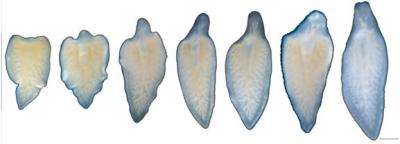Heading for regeneration

The rabbit can't do it, neither can a frog, but zebrafish and axolotls can and flatworms are true masters of the craft: Regeneration. Why some animals can re-grow lost body parts or organs while others cannot remains a big mystery. And even more intriguing to us regeneration-challenged humans is the question whether one might be able to activate regenerative abilities in species that don't usually regenerate.
Researchers at the Max Planck Institute of Molecular Cell Biology and Genetics in Dresden are now one step further in understanding the factors that regulate regeneration. They discovered a crucial molecular switch in the flatworm Dendrocoelum lacteum that decides whether a lost head can be regenerated or not. And what is even more spectacular: The scientists manipulated the genetic circuitry of the worm in such a way as to fully restore its regeneration potential.
In his lab, Jochen Rink, research group leader at the MPI-CBG, usually studies the flatworm species Schmidtea mediterranea. It is known for its excellent regenerative abilities and thus a popular model species in regeneration research: "We can cut the worm to 200 pieces, and 200 new worms will regenerate from each and every piece", Rink explains. Now, for a change, Rink and colleagues brought a different beast into the lab, the flatworm Dendrocoelum lacteum. Even though a close cousin of the regeneration master S. mediterranea, this species had been reported to be incapable of regenerating heads from its posterior body half. "What's the salient difference between the two cousins", the researcher asked?
Together with researchers from the Center for Regenerative Therapies Dresden Rink's team searched for an answer amongst the genes of the two species, focusing on the so-called Wnt-signaling pathway. Like a cable link between two computers, signalling pathways transmit information between cells. The Dresden researchers inhibited the signal transducer of the Wnt pathway with RNAi and thus made the cells of the worm believe that the signalling pathway had been switched to "off". Consequently, Dendrocoelum lacteum were able to grow a fully functional head everywhere, even when cut at the very tail.
Re-building a head complete with brain, eyes and all the wiring in between is evidently complicated business. However, as the study showed, regeneration defects are not necessarily irreversible. Jochen Rink is stunned: "We thought we would have to manipulate hundreds of different switches to repair a regeneration defect; now we learned that sometimes only a few nodes may do". Will this knowledge soon be applicable to more complex organisms – like humans, for example? "We showed that by comparisons amongst related species we can obtain insights into why some animals regenerate while others don't – that's an important first step".
More information:
DOI: 10.1038/nature12359
DOI: 10.1038/nature12414
DOI: 10.1038/nature12403

















